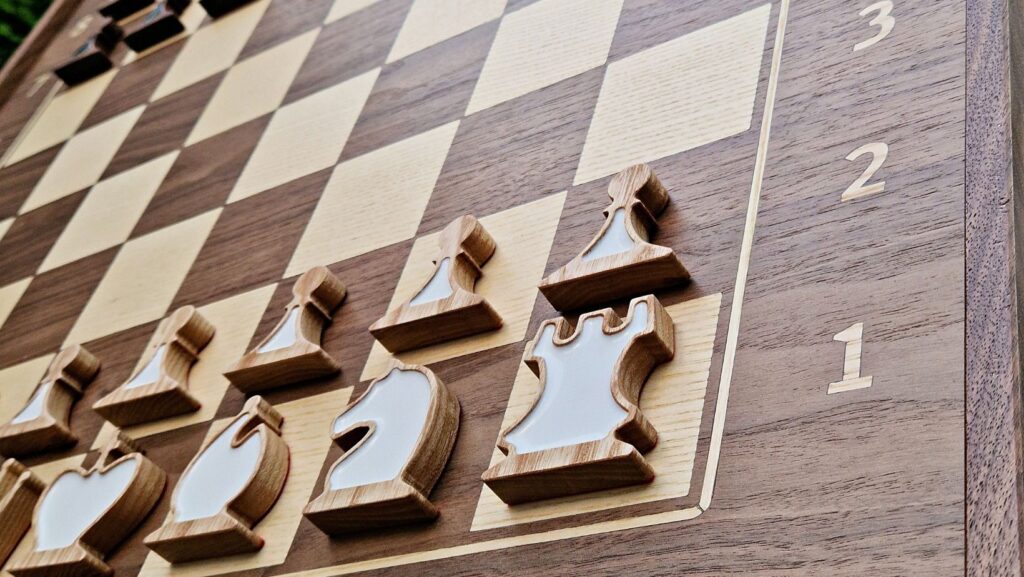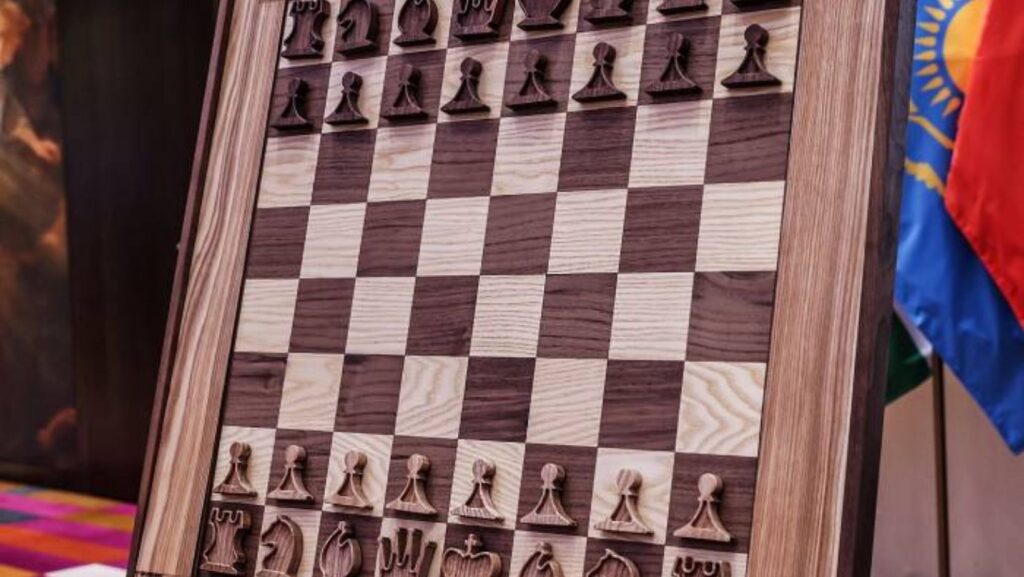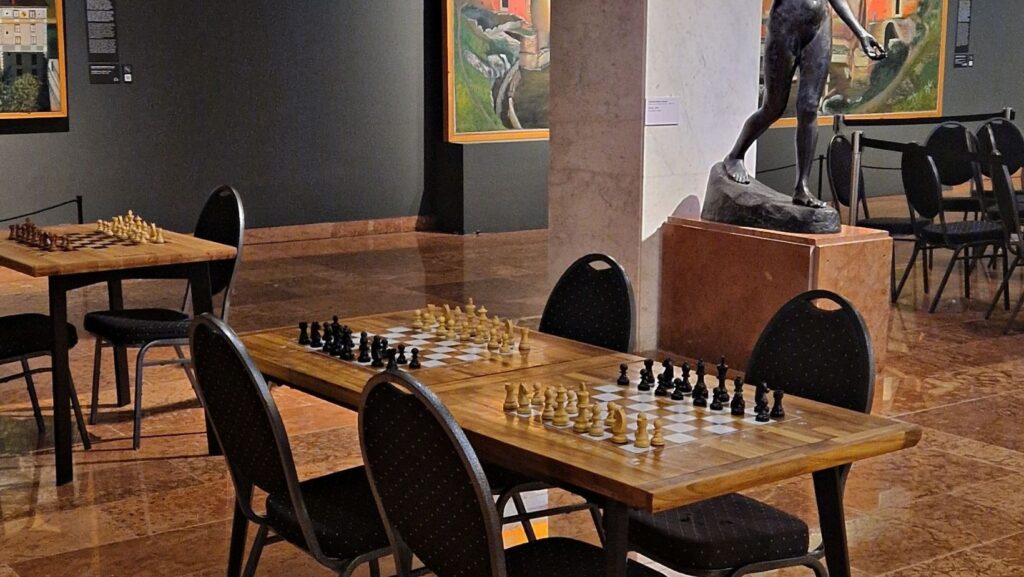Most clubs outgrow a folding board fast. If you run meetups, school nights or weekend events, you need two things: (1) a proper chess table that’s comfortable for long games and blitz, and (2) a vertical analysis board that’s always set up and invites people to interact. Add a bughouse module and your open nights become a magnet. This guide shares field-tested specs—sizes, materials, logistics—and shows how to scale from a single table to a lively corner that runs itself.
Why a “club-ready” setup matters
Readability & focus
Players sit, hit the clock, and focus when the board is easy to read: 55–60 mm squares for 3.75–4.0″ kings, clear coordinates, and high contrast. No glare, no wobble, no searching for space.
Flow between play and analysis
Games happen at tables; explanations happen on the wall. A vertical board lets coaches demonstrate patterns and lets members resume yesterday’s positions the moment they walk in.
Equipment that lasts
Heavy, stable tops; level faces; finishes chosen for daily cleaning. These choices save money and frustration over a season.
Tournament table spec (your dependable baseline)
Dimensions that work
- Squares: 55–60 mm for adult play.
- Height: ~74 cm for standard chairs (±2 cm).
- Footprint: width in the mid-700s mm and length ≥ ~900 mm leaves arm room, clock space and a safe zone for captured pieces.
- Coordinates: engraved/printed notation speeds training and adjudication.
Surfaces: epoxy vs wood inlay
- Epoxy (CNC → epoxy pour → full-surface sanding → finish): glass-flat, wipe-clean, modern contrast; ideal for high-traffic rooms.
- Wood inlay (intarsia): classic, tactile, warm under fingers; light oil/wax care a few times a year.
Common pitfalls
Low-contrast “stylish” squares that look great in photos but are hard to read; thin tabletops that wobble; square sizes under 50 mm for adults (fatigue, fumbles).
The vertical analysis board (always set up, always inviting)
Viewing distance & size matrix
From 2–3 m, 50–56 mm squares are a sweet spot. Keep coordinates calm but legible. Prioritise contrast (walnut vs pearl-white; ash vs black).
Magnet engineering (why pieces don’t slide)
A dense magnet grid in the board plus magnetised pieces calibrated for shear resistance (against downward slide), not just pull force. The face is sanded to one plane, so pieces lift quietly with no “clack”.
Mounting & safety
Use hardware rated far above the board’s mass.
- Drywall/stud: into studs or heavy-duty anchors.
- Brick/concrete: plugs + screws.
- Height: centre at 140–160 cm (lower for juniors).
Choose systems that allow lift-off service for cleaning or relocation.
Bughouse as a plug-in (and why it transforms club nights)
Layout anatomy
Two full boards, a centre separator so hands don’t collide, and a clock shelf for both teams. This controls chaos and improves timing.
Recommended spec (field-tested)
- Iroko hardwood top for durability and mass.
- 56 mm squares (comfortable for 3.75–4.0″ kings).
- Five-piece bolted top that packs flat; assembly in minutes with a hex key.
- Overall ~150 × 75 cm.
- Finish: perfectly level, wipe-clean, stable for blitz.
Use cases that shine
Open nights, inter-school festivals, finals after a rapid event. The station becomes a spectator magnet and a training tool for hand-off coordination.
Logistics that make organisers’ lives easier
Transport & storage
Modular tops with captive hardware avoid lost bolts; numbered parts speed assembly. Panels fit a hatchback or closet.

Cleaning & finish choice
Resin faces and hard varnishes are wipe-clean; inlay loves oil/wax and a soft cloth. Pick per venue: café vs school vs dedicated club room.
Upgrades (when you’re ready)
DGT/electronics recessed with hidden cable channels; pre-drilled tops for steel spider/trapezoid legs; anti-glare satin finishes for streams.
Example setups (scale what you need)
A) Small club / after-school program
- 2 tournament tables (55–58 mm)
- 1 vertical board for lessons/demos
- Optional: one shared bughouse night per month
B) Growing city club
- 6–10 tournament tables (mix epoxy & inlay)
- 2 vertical boards (main hall + juniors)
- 1 permanent bughouse station
C) Streamer / coach studio
- 1 tournament-feel table with coordinates
- 1 vertical board behind presenter (lighting tuned to reduce glare)
- Satin finish preferred for cameras
D) Café / venue hybrid
- 2–4 compact tables (50–55 mm if space is tight)
- 1 vertical board to invite walk-ups
- Sturdy bases and wipe-clean surfaces
Budgeting & priorities
What to buy first
Spend first on surface quality (flatness, contrast) and stability (good legs, enough mass). Then add a vertical board—it multiplies lesson value and keeps positions alive between sessions.
Where to save (without regrets)
Fancy inlays and exotic woods can wait. Get the dimensions and finish right; you can upgrade looks later.
When to go bespoke
Odd room sizes, TV/stream constraints, or a signature “showpiece” wall—custom drawings and pre-drilled tops solve headaches before they appear.
Purchasing checklist (print-friendly)

Tables
- Squares 55–60 mm, height ~74 cm, coordinates readable
- Flat face (no rocking pieces), room for clock/scoresheet
- Finish matched to cleaning reality (resin/varnish vs oil/wax)
Vertical boards
- Squares 50–56 mm for 2–3 m viewing distance
- High-contrast pairs, calm coordinates
- Board magnet grid + magnetised pieces calibrated for shear
- Discreet, rated hangers; lift-off service; correct height
Bughouse stations
- 2 boards + centre separator + clock shelf
- Modular top, captive hardware, numbered parts
- Durable, perfectly level surface
FAQ
3.75″ vs 4.0″ king — what square size?
For 3.75″ kings use 55–58 mm; for 4.0″ kings 58–60 mm keeps comfort and readability.
Do vertical pieces ever slide?
With a dense magnet grid in the board and magnetised pieces tuned for shear resistance, no. A level face is essential.
Epoxy or inlay for clubs?
Epoxy: glass-flat, wipe-clean, strong contrast—great for high traffic. Inlay: classic, tactile, ages beautifully with oil/wax care.
Can we run bughouse on a normal table?
Possible, but cramped. A separator and clock shelf transform playability and reduce mess.
What about DGT/electronics?
Recesses and cable channels keep things tidy; popular for streams and classrooms.
Where to start (place the link here)
If you’re building or upgrading a club corner, begin with a vertical analysis board—it delivers the biggest day-to-day impact for coaching and club culture. Then standardise table specs so players feel at home. When you’re ready to add sizzle, a bughouse station turns every open night into a mini-festival.
Explore vertical chess by ChessboArt — functional art you can play, engineered for classrooms, clubs and living rooms.

